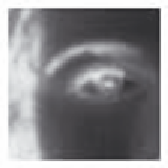Image Processing Reference
In-Depth Information
By substitution of Equation 4.16 in Equation 4.18,
2
(
G
P
n
)
= 0
(4.19)
2
Equation 4.19 provides the basis for an operator which meets one of Canny's criteria,
namely that edges should be detected in the correct place. This is non-maximum suppression,
which is equivalent to retaining peaks (a.k.a. differentiation perpendicular to the edge),
which thins the response of the edge detection operator to give edge points which are in the
right place, without multiple response and with minimal response to noise. However, it is
virtually impossible to achieve an exact implementation of Canny given the requirement to
estimate the normal direction.
A common approximation is, as illustrated in Figure
4.15
:
1.
use Gaussian smoothing (as in Section 3.4.4), Figure
4.15
(a);
2.
use the Sobel operator, Figure
4.15
(b);
3.
use non-maximal suppression, Figure
4.15
(c);
4.
threshold with hysteresis to connect edge points, Figure
4.15
(d).
(a) Gaussian smoothing
(b) Sobel edge detection
(c) Non-maximum
(d) Hysteresis
suppression
thresholding
Figure 4.15
Stages in Canny edge detection
Note that the first two stages can be combined using a version of Equation 4.15, but are
separated here so that all stages in the edge detection process can be shown clearly. An
alternative implementation of Canny's approach (Deriche, 1987) used Canny's criteria to
develop two-dimensional recursive filters, claiming performance and implementation
advantage over the approximation here.
Non-maximum suppression essentially locates the highest points in the edge magnitude
data. This is performed by using edge direction information, to check that points are at the
peak of a ridge. Given a 3 × 3 region, a point is at a maximum if the gradient at either side
of it is less than the gradient at the point. This implies that we need values of gradient along
a line which is normal to the edge at a point. This is illustrated in Figure
4.16
, which shows
the neighbouring points to the point of interest,
P
x,y
, the edge direction at
P
x,y
and the
normal to the edge direction at
P
x,y
. The point
P
x,y
is to be marked as a maximum if its
gradient,
M
(
x
,
y
), exceeds the gradient at points 1 and 2,
M
1
and
M
2
, respectively. Since we
have a discrete neighbourhood,
M
1
and
M
2
need to be interpolated. First-order interpolation
using
Mx
and
My
at
P
x,y
, and the values of
Mx
and
My
for the neighbours gives:





















